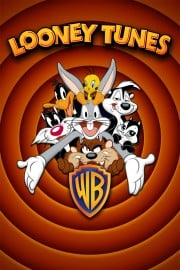In the 1953 episode of Looney Tunes titled A Street Cat Named Sylvester, viewers are treated to a delightful and humorous tale that showcases the iconic antics of Sylvester the Cat. This episode captures the essence of the classic series, blending slapstick comedy with clever storytelling that appeals to audiences of all ages.
Set against the bustling backdrop of a city neighborhood, the episode begins with Sylvester navigating the challenges of street life as a scrappy feline determined to make his way in a world teeming with obstacles. The animation brings the urban environment to life, highlighting the vibrant colors and lively movements that are hallmarks of the Looney Tunes franchise.
As a street cat, Sylvester embodies both the scrappiness and cunning often associated with his character. He is portrayed as a lovable yet bumbling creature, whose ambitious pursuits frequently lead to comic misadventures. The episode is skillfully crafted, utilizing a series of sight gags and physical comedy that elevate the humor to new heights.
The plot of A Street Cat Named Sylvester revolves around Sylvester’s incessant desire to catch the elusive Tweety Bird, a common motif throughout the Looney Tunes series. Sylvester’s attempts are met with his trademark klutziness, resulting in a series of failed schemes that only endear him to the audience. The interactions between Sylvester and other characters are cleverly written, filled with witty dialogue and exuberant expressions that enhance the comedic timing.
As Sylvester embarks on his quest, he encounters a variety of characters that contribute to his misadventures. Each encounter highlights different aspects of his personality—from his stubbornness to his inability to learn from past mistakes. The charming yet chaotic nature of the street creates an unpredictable environment, keeping viewers engaged as Sylvester navigates through oddly imaginative situations.
The animation style of the era shines brightly in this episode. The exaggerated movements and expressive character designs depict both the frenetic energy of Sylvester’s pursuits and the playful spirit of the series. The fluidity of the animation adds depth to Sylvester’s character, showcasing his frustration, determination, and ultimately, his comedic failures.
Music plays a significant role in enhancing the episode's charm. The lively score underscores the action, adding a whimsical atmosphere that aligns perfectly with the slapstick humor. The catchy tunes and sound effects amplify the comedic moments, ensuring that each chase, slip, and fall resonates with laughter.
Throughout A Street Cat Named Sylvester, the dynamic between the characters serves as a focal point. Sylvester's interactions with Tweety, as well as any other characters that enter the scene, create a playful rivalry. This tension is palpable as viewers find themselves rooting for Sylvester's success while simultaneously laughing at his blunders. The contrast between Sylvester’s bold ambitions and his comical failures creates a rich narrative tension that defines the episode.
As the climax builds, the episode uses clever setups that keep the audience guessing. Will Sylvester finally outsmart Tweety? Or will he find himself tangled in yet another hapless predicament? The humor is derived not only from the action but also from the relatable essence of Sylvester's character—his ambition, frustrations, and the universal struggle of trying to achieve one’s goals despite overwhelming odds.
Looney Tunes episodes are often filled with a sense of nostalgia, and A Street Cat Named Sylvester is no exception. It encapsulates the timeless charm of the series, appealing to those familiar with the classic characters while also inviting new viewers into the whimsical world. The clever storytelling and engaging plot twists ensure that audiences remain entertained from start to finish.
With each passing moment, the episode showcases the timeless artistry of classic animation. The vibrant colors, detailed backgrounds, and lively character designs all contribute to the overall enjoyment. Whether it’s Sylvester’s exaggerated expressions or the playful antics of Tweety, each element blends together beautifully.
A Street Cat Named Sylvester is a delightful episode that highlights the enduring appeal of Sylvester as a beloved character. His charm, comedic timing, and relentless determination make for an entertaining viewing experience. The laughter and excitement generated throughout the episode remind audiences of the joy and creativity that have captivated generations of fans.
In conclusion, A Street Cat Named Sylvester stands as a testament to the ingenuity of Looney Tunes. It is a perfect blend of humor, animation, and storytelling, representing the best of what the series has to offer. Each hilarious moment invites viewers to engage with the antics on screen, celebrating the spirit of classic animation while leaving them eager for more.
-
Genres
-
Channel
-
First AiredSeptember 5, 1953
-
LanguageEnglish









